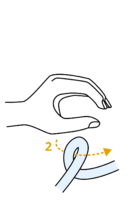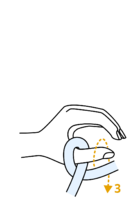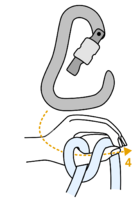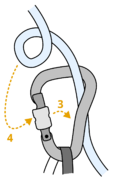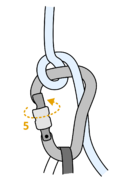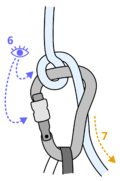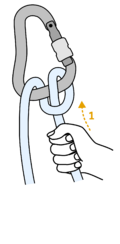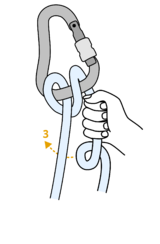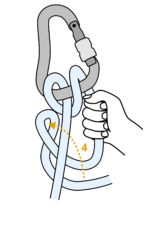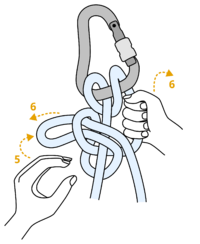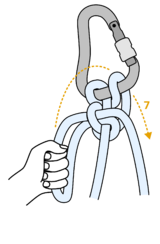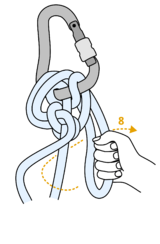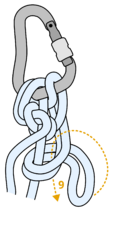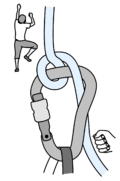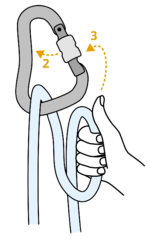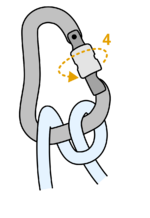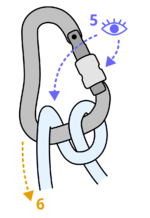Munter hitch
| Munter hitch | |
|---|---|
 | |
| Other names | HMS, HMS knot, munter |
| Use(s) | Belaying, rescue techniques |
| Pros | Fast, simple, just HMS carabiner needed |
| Cons | Rope abrasion, rope tangling, no braking assist |
| Category | Hitch |
Munter hitch (also known as HMS) is an essential knot used for belaying in occasions when a belay device cannot be used. It is also used in advanced rope techniques (for example rescue techniques).
Quick overview
Tying and Tie-off
Tying for an anchor belay (easy method)
This method is very robust and suitable for learning how to tie the hitch.
Steps description: start with making a loop on a rope (1) and pull the loop on your thumb (2). Then place another strand over your thumb (3) and close the hand with your index finger. Next, pull the carabiner exactly through the rope in the path of your thumb (4). Screw the safety-lock (5), inspect that everything is correct (6) and pull the break-strand (7) to test if the munter hitch flips into another munter as a final check.
Tying for a harness belay
Steps description: start with a rope through the carabiner which is attached to your harness. Take a bite of a rope (1) and create a loop (2). Then you open the carabiner gate (3) and seat the loop into the carabiner (4). Screw the safety-lock (5), inspect that everything is correct (6) and pull the break-strand (7) to test if the munter hitch flips into another munter as a final check.
Tie-off - Mule overhand
Belaying
Always hold the break strand! Belaying with Munter hitch is reliable and reasonably comfortable. Munter works smoothly when not loaded, yet giving friction to catch a fall once tensioned. It blocks regardless of the angle of the breaking hand. The main reason why it is used less often is that if the rope is pulled through the hitch under tension, Munter tends to tangle the rope.
Belaying risks
When belaying with Munter hitch, aside from always holding the break strand, belayer should pay attention to keep fingers at a respectful distance from the knot, otherwise he might risk jamming his fingers into the belay, which might result in a severe finger injury. Belayer should also ensure to tie the Munter in a way that it does not interfere with the carabiner gate/lock. Otherwise the rope friction might unlock, and maybe even open the gate of the carabiner.
In-depth section
Tying
For tying, see the methods below.
Single hand method
Fast method using single hand move.
Steps description: Start with a rope through a carabiner. Grab the rope strand closer to you behind the other strand. Pull the rope strand closer to you below the other strand (1) and up, open the gate (2) and pull the rope through the gate from the front to back and sit the rope into the carabiner (3), the gate closes itself automatically. Screw the safety-lock (4) and visually inspect that everything is correct (5) and pull the break-strand (6) to see if the munter hitch flips into another munter hitch as a final check.
Detailed method
Step-by-step, very detailed description.
File:Munter tie step1.png File:Munter tie step2.png File:Munter tie step3.png File:Munter tie step4.png File:Munter tie step5.png File:Munter tie step6.png File:Munter tie step7.png
Steps description: Start with a rope through a carabiner. Pull the rope strand closer to you below the other strand (1), open the gate (2) and pull the rope through the gate from the front (3). sit the rope into the carabiner (4) and close the gate (5). Screw the safety-lock (6), visually inspect that everything is correct (7) and pull the break-strand (8) to see if the munter hitch flips into another munter hitch as a final check (9).

